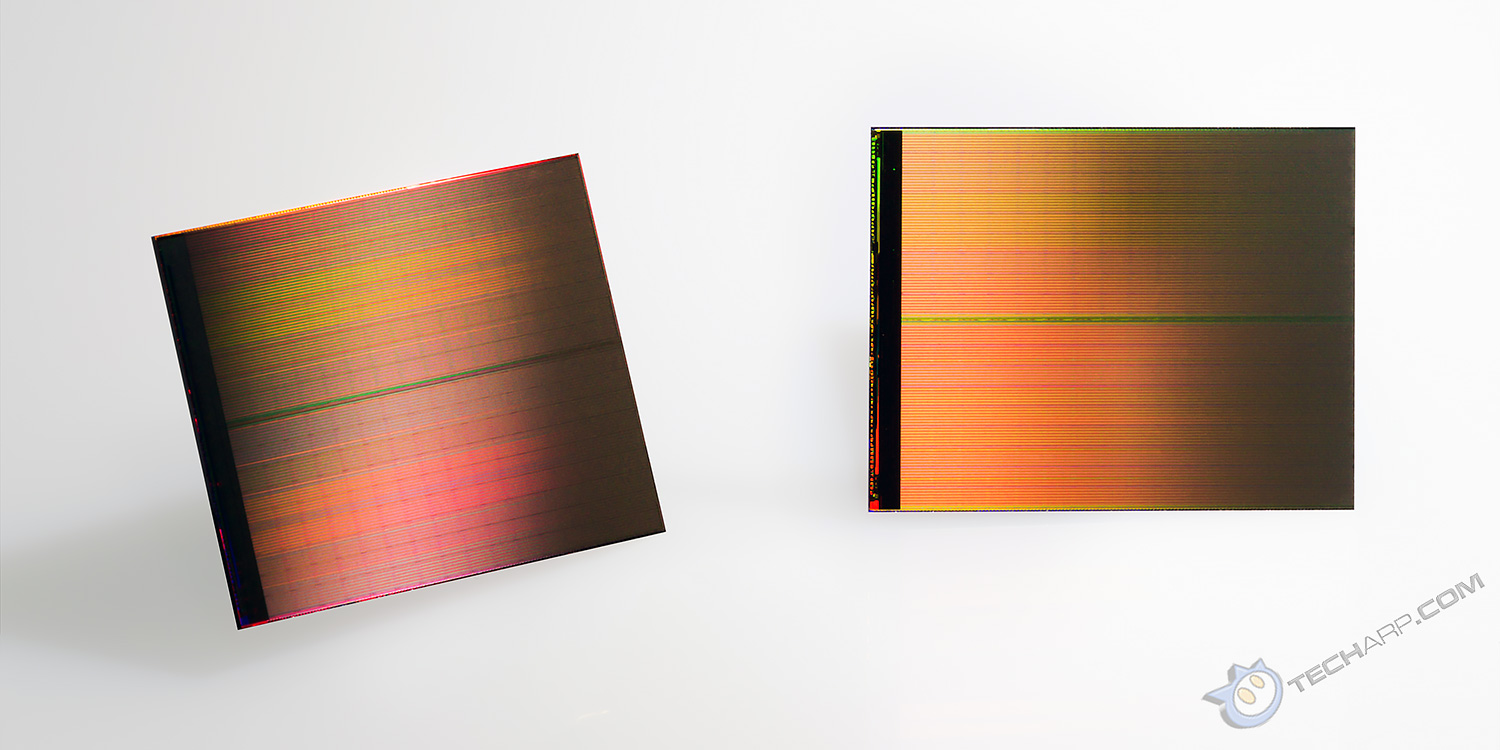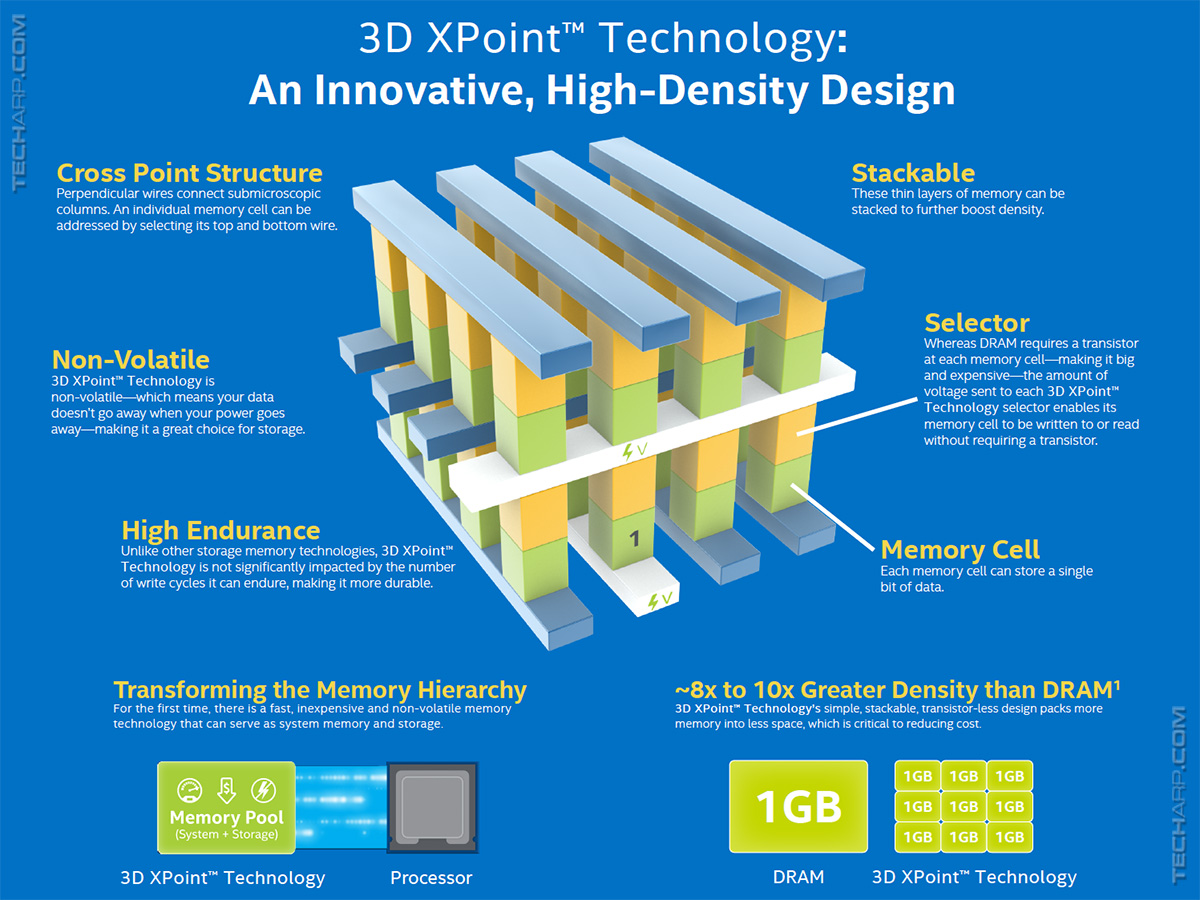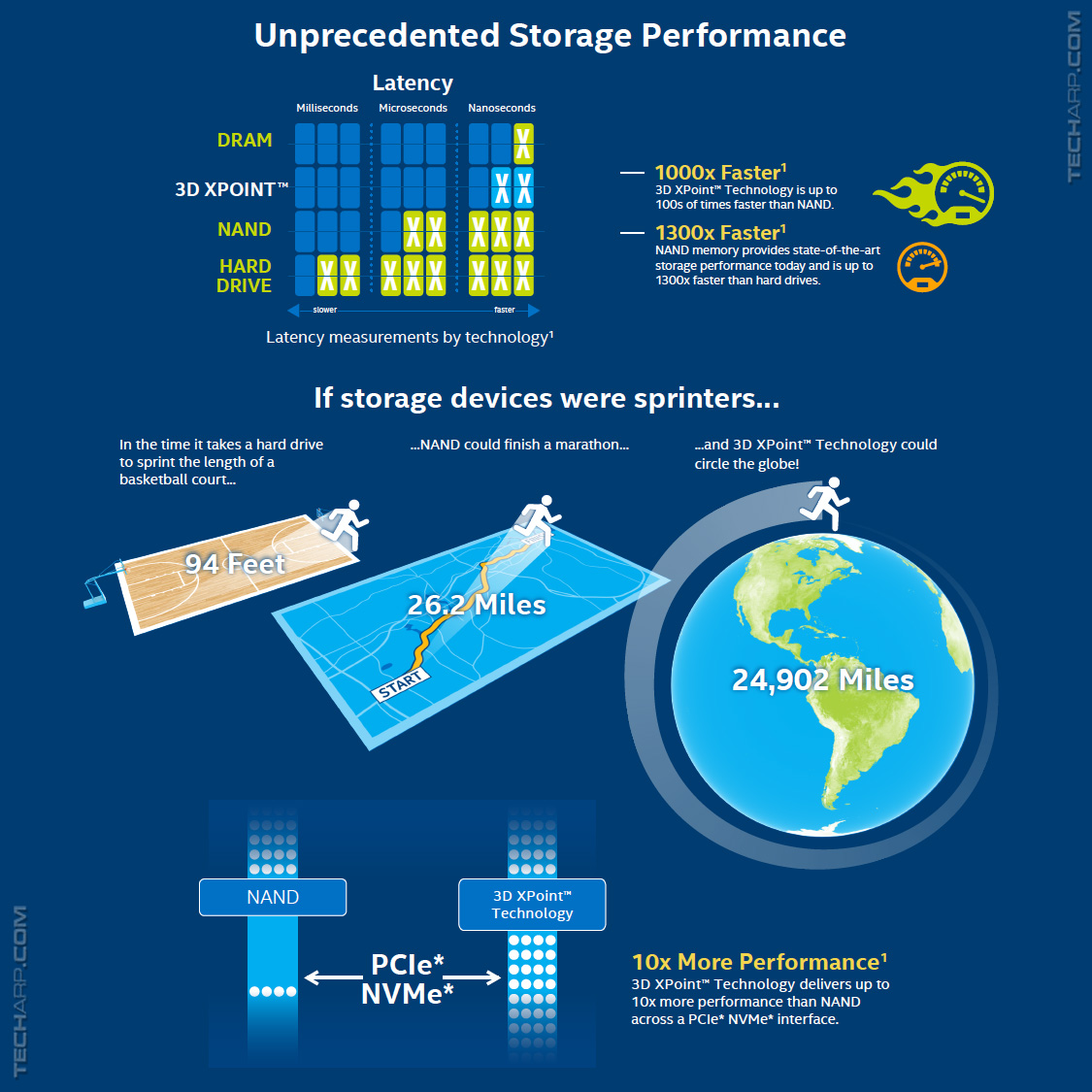The 3D XPoint Press Release
SANTA CLARA, Calif., and BOISE, Idaho, July 29, 2015 – Intel Corporation and Micron Technology, Inc. today unveiled 3D XPoint™ technology, a non-volatile memory that has the potential to revolutionize any device, application or service that benefits from fast access to large sets of data. Now in production, 3D XPoint technology is a major breakthrough in memory process technology and the first new memory category since the introduction of NAND flash in 1989.
The explosion of connected devices and digital services is generating massive amounts of new data. To make this data useful, it must be stored and analyzed very quickly, creating challenges for service providers and system builders who must balance cost, power and performance trade-offs when they design memory and storage solutions. 3D XPoint technology combines the performance, density, power, non-volatility and cost advantages of all available memory technologies on the market today. The technology is up to 1,000 times faster and has up to 1,000 times greater endurance than NAND, and is 10 times denser than conventional memory.
“For decades, the industry has searched for ways to reduce the lag time between the processor and data to allow much faster analysis,” said Rob Crooke, senior vice president and general manager of Intel’s Non-Volatile Memory Solutions Group. “This new class of non-volatile memory achieves this goal and brings game-changing performance to memory and storage solutions.”
“One of the most significant hurdles in modern computing is the time it takes the processor to reach data on long-term storage,” said Mark Adams, president of Micron. “This new class of non-volatile memory is a revolutionary technology that allows for quick access to enormous data sets and enables entirely new applications.”
As the digital world quickly grows – from 4.4 zettabytes of digital data created in 2013 to an expected 44 zettabytes by 2020 – 3D XPoint technology can turn this immense amount of data into valuable information in nanoseconds. For example, retailers may use 3D XPoint technology to more quickly identify fraud detection patterns in financial transactions; healthcare researchers could process and analyze larger data sets in real time, accelerating complex tasks such as genetic analysis and disease tracking.
The performance benefits of 3D XPoint technology could also enhance the PC experience, allowing consumers to enjoy faster interactive social media and collaboration as well as more immersive gaming experiences. The non-volatile nature of the technology also makes it a great choice for a variety of low-latency storage applications since data is not erased when the device is powered off.
New Recipe, Architecture for Breakthrough Memory Technology
Following more than a decade of research and development, 3D XPoint technology was built from the ground up to address the need for non-volatile, high-performance, high-endurance and high-capacity storage and memory at an affordable cost. It ushers in a new class of non-volatile memory that significantly reduces latencies, allowing much more data to be stored close to the processor and accessed at speeds previously impossible for non-volatile storage.
The innovative, transistor-less cross point architecture creates a three-dimensional checkerboard where memory cells sit at the intersection of word lines and bit lines, allowing the cells to be addressed individually. As a result, data can be written and read in small sizes, leading to faster and more efficient read/write processes.
More details about 3D XPoint technology include:
-
Cross Point Array Structure – Perpendicular conductors connect 128 billion densely packed memory cells. Each memory cell stores a single bit of data. This compact structure results in high performance and high-density bits.
-
Stackable – In addition to the tight cross point array structure, memory cells are stacked in multiple layers. The initial technology stores 128Gb per die across two memory layers. Future generations of this technology can increase the number of memory layers, in addition to traditional lithographic pitch scaling, further improving system capacities.
-
Selector – Memory cells are accessed and written or read by varying the amount of voltage sent to each selector. This eliminates the need for transistors, increasing capacity while reducing cost.
-
Fast Switching Cell – With a small cell size, fast switching selector, low-latency cross point array and fast write algorithm, the cell is able to switch states faster than any existing non-volatile memory technology today.
240 GB HyperX Savage SSD Review
| If you like this article, please share it! -> |
3D XPoint Key Points & Infographics
For your convenience, we present to you a summary of the key points of 3D XPoint memory :
- Development began in 2012 at the Micron fab in Boise, Idaho.
- Manufacturing development has started at the IM Flash fab in Lehi, Utah.
- Sampling to begin at the end of 2015, with availability expected in 2016.
- Current capacity - 128 Gbits per die
- Manufactured on a 20 nm node process technology
- New cross point structure allows individual memory cell to be accessed independently.
- The cross point structure is stackable for higher storage density.
- New memory cell uses "bulk material property change" to store data. It is a kind of bulk resistive memory technology.
- Each memory cell stores one bit of data.
- No erase before write required. Each bit can be written to immediately.
- Each memory cell can be accessed independently, as opposed to an entire block in NAND flash memory.
- Projected to be up to 1,000 times faster and up to 1,000 times more durable than NAND flash memory.
- Projected to have up to 10 times denser storage capacity than DRAM.
In addition, here is a 3D XPoint infographic that demonstrates the unique cross point structure, as well as its key advantages.
Finally, here is a 3D XPoint infographic that illustrates how much faster 3D XPoint is, compared to NAND flash memory.
Hands On With The AMD Radeon R9 Fury X, R9 Fury X2 & R9 Nano
| If you like this article, please share it! -> |
Support Tech ARP!
If you like our work, you can help support out work by visiting our sponsors, participate in the Tech ARP Forums, or even donate to our fund. Any help you can render is greatly appreciated!
Page |
The Intel-Micron 3D XPoint Technology Report |
1 |
|
2 |
|
3 |
Support us by buying from Amazon.com! |
|
| Grab a FREE 30-day trial of Amazon Prime for free shipping, instant access to 40,000 movies and TV episodes and the Kindle Owners' Lending Library! | |
Questions & Comments
If you have a question or comment on this editorial, please feel free to post them here!
Date |
Revision |
Revision History |
| 29-07-2015 | 1.0 |
Initial Release. |







 Add to Reddit
Add to Reddit




